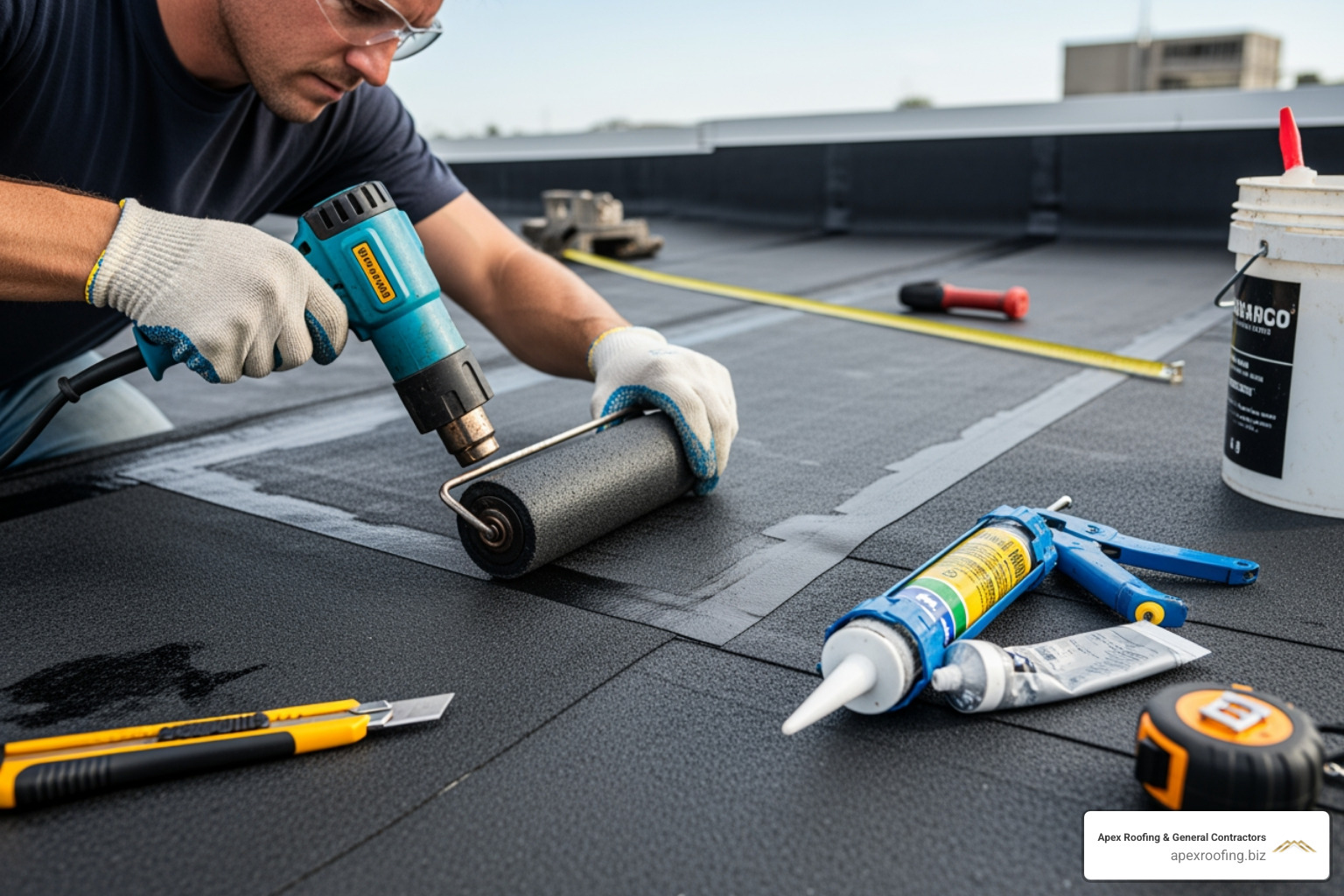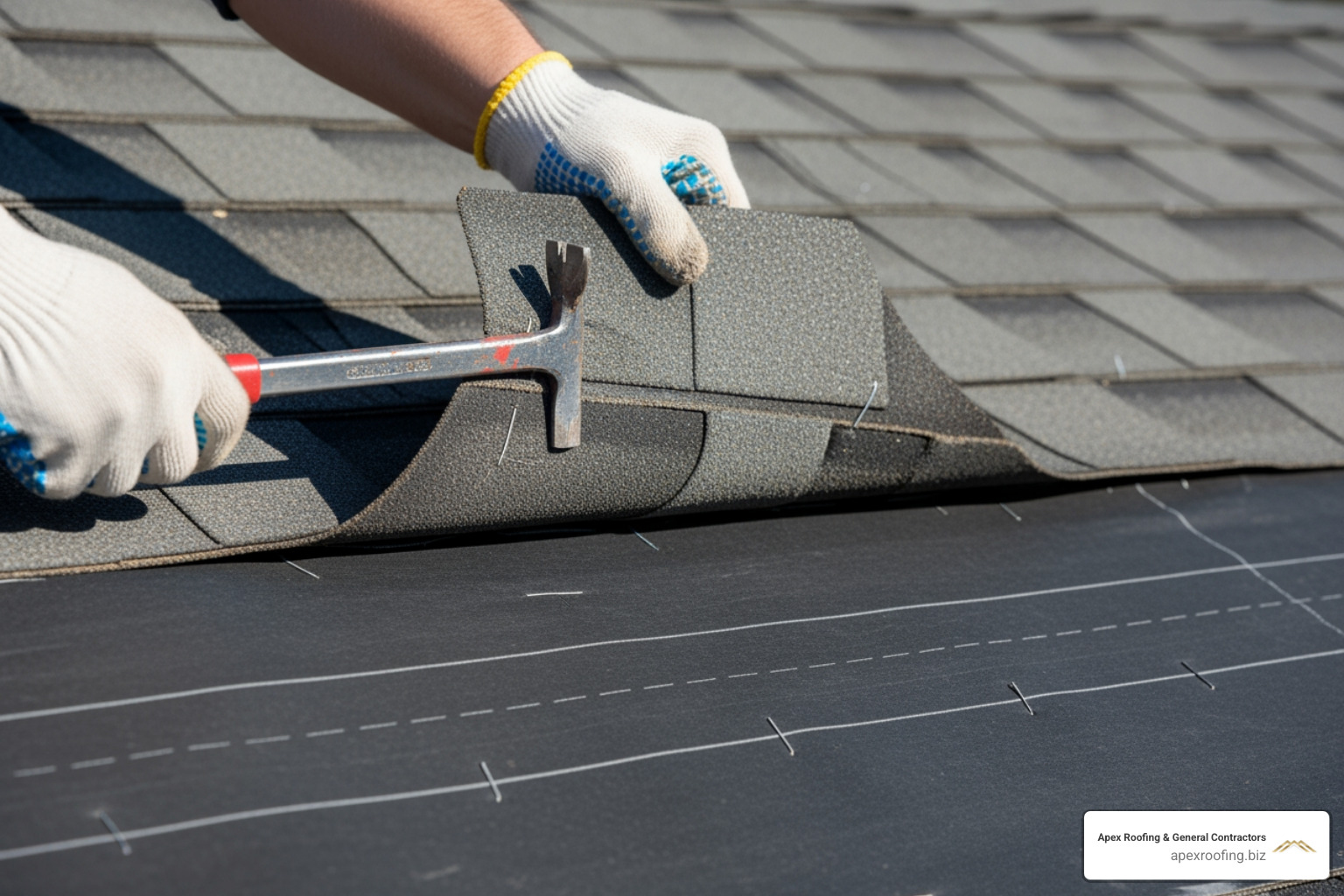Why Understanding Roof Insurance Claims Can Save You Thousands
Roof insurance claims are a vital resource for homeowners facing unexpected roof damage. When a storm compromises your roof, knowing how to steer the claims process can mean the difference between a full recovery and paying thousands out of pocket. Understanding your policy, documenting damage, and working with professionals are key to securing a fair settlement. For homeowners in Texas, working with trusted San Antonio roofing experts who understand local conditions and insurance procedures is crucial.
The average home insurance claim for wind and hail damage is around $13,000, while roof replacement costs can range from $9,000 to $10,000. A successful claim ensures you receive the funds you’re entitled to under your policy. However, the paperwork, deadlines, and jargon can be overwhelming. That’s why professional guidance on roof repair services is so valuable.
I’m Carlos Yzaguirre, President of Apex Roofing & General Contractors. Since 2022, my team and I have helped hundreds of San Antonio homeowners successfully steer roof insurance claims. We work directly with insurance adjusters to ensure our clients receive fair settlements and quality repairs that restore their homes’ protection.
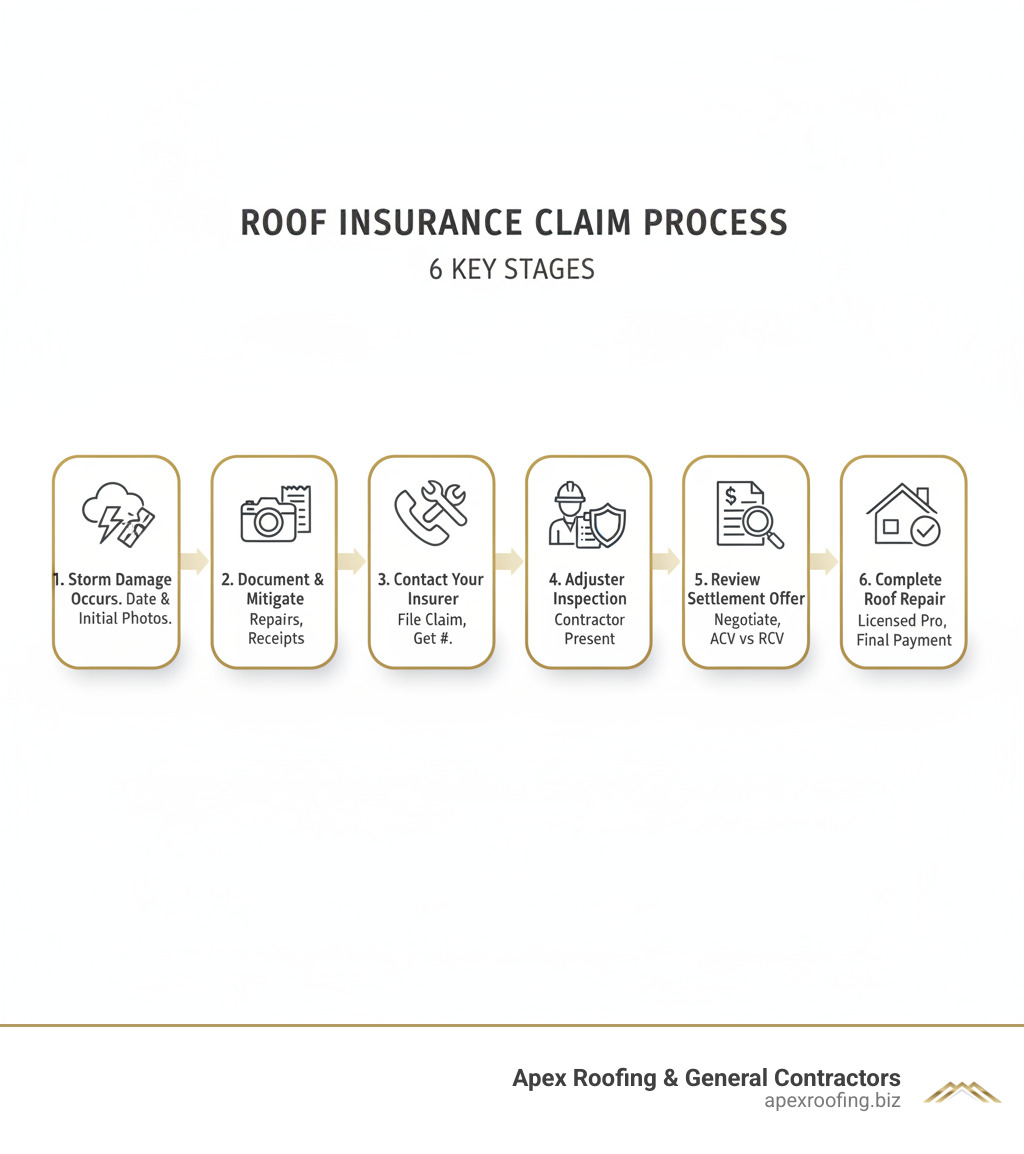
Understanding Your Policy and What It Covers
Before filing roof insurance claims, understand your homeowners insurance policy. Most policies are designed to cover sudden and accidental damage, not problems that develop from neglect or old age. Think of it as emergency protection, not a maintenance plan.
What Roof Damage Is Typically Covered?
Homeowners insurance generally covers roof damage from “covered perils”—sudden, unexpected events outside your control. These include:
- Windstorms: Damage from high winds tearing off shingles or lifting flashing.
- Hail Damage: Bruising or punctures from hailstones that compromise your roof’s integrity. Learn what hail damage looks like to identify it correctly.
- Fire and Lightning: Almost universally covered.
- Falling Objects: Damage from tree limbs or other debris.
- Vandalism: Malicious damage to your property.
- Weight of Ice or Snow: Structural damage or collapse from heavy accumulation.
If a covered peril causes a leak, your insurer will likely pay for repairs. For more details, this resource on covered perils and roof leaks is helpful.
Common Exclusions in Homeowners Insurance
Understanding what your policy won’t cover is just as important. Common exclusions include:
- Wear and Tear: General aging, faded shingles, or minor granule loss over time.
- Neglect or Poor Maintenance: Damage from uncleaned gutters, moss growth, or ignored small issues.
- Faulty Workmanship: Problems caused by improper installation from a previous contractor.
- Pest Damage: Damage from rodents or insects.
- Floods and Earthquakes: These require separate, specific insurance policies.
- Cosmetic Damage: Some policies exclude minor dents from hail that don’t affect the roof’s function.
Your roof’s age is a major factor. Insurers may argue that damage on an older roof is due to deterioration rather than a storm, potentially leading to a denied claim or a reduced payout.
ACV vs. RCV: A Critical Distinction for Your Payout
The difference between Actual Cash Value (ACV) and Replacement Cost Value (RCV) can impact your payout by thousands of dollars.
| Feature | ACV (Actual Cash Value) | RCV (Replacement Cost Value) |
|---|---|---|
| Definition | The value of your roof after deducting for age and wear. | The full cost to replace your roof with new, similar materials. |
| Payout Calculation | Replacement Cost minus Depreciation. You pay the difference. | Initial ACV payment, then the withheld depreciation is paid after repairs are complete. |
| Out-of-Pocket Cost | Higher. You cover the depreciation amount. | Lower. You only pay your deductible. |
| Best For | Homeowners with lower premiums who can cover higher out-of-pocket costs. | Homeowners who want maximum protection and minimal surprise expenses. |
With an RCV policy, the insurer initially pays the ACV (minus your deductible) and holds back the remaining amount, called “recoverable depreciation.” Once repairs are finished and documented, the insurer releases the depreciation amount to you. This two-step process ensures the repairs are actually completed. For a clear breakdown, see this guide on understanding depreciation.
How Deductibles Affect Your Claim
Your deductible is the amount you pay out of pocket before your insurance coverage kicks in. For roof insurance claims, the insurer subtracts your deductible from the total approved claim amount.
- Flat-Rate Deductibles: A fixed dollar amount (e.g., $1,000, $2,500).
- Percentage-Based Deductibles: Common for wind and hail in areas like San Antonio. This is a percentage (e.g., 1% or 2%) of your home’s total insured value. A 2% deductible on a $300,000 home is $6,000, a significant out-of-pocket cost.
Not all damage warrants a claim. If your repair estimate is close to or less than your deductible, it’s often better to pay out of pocket. This protects your claims history from minor issues, which can prevent premium increases or non-renewal down the line. We typically advise paying out of pocket for repairs that cost less than your deductible plus $1,000.
The Step-by-Step Guide to Filing Roof Insurance Claims
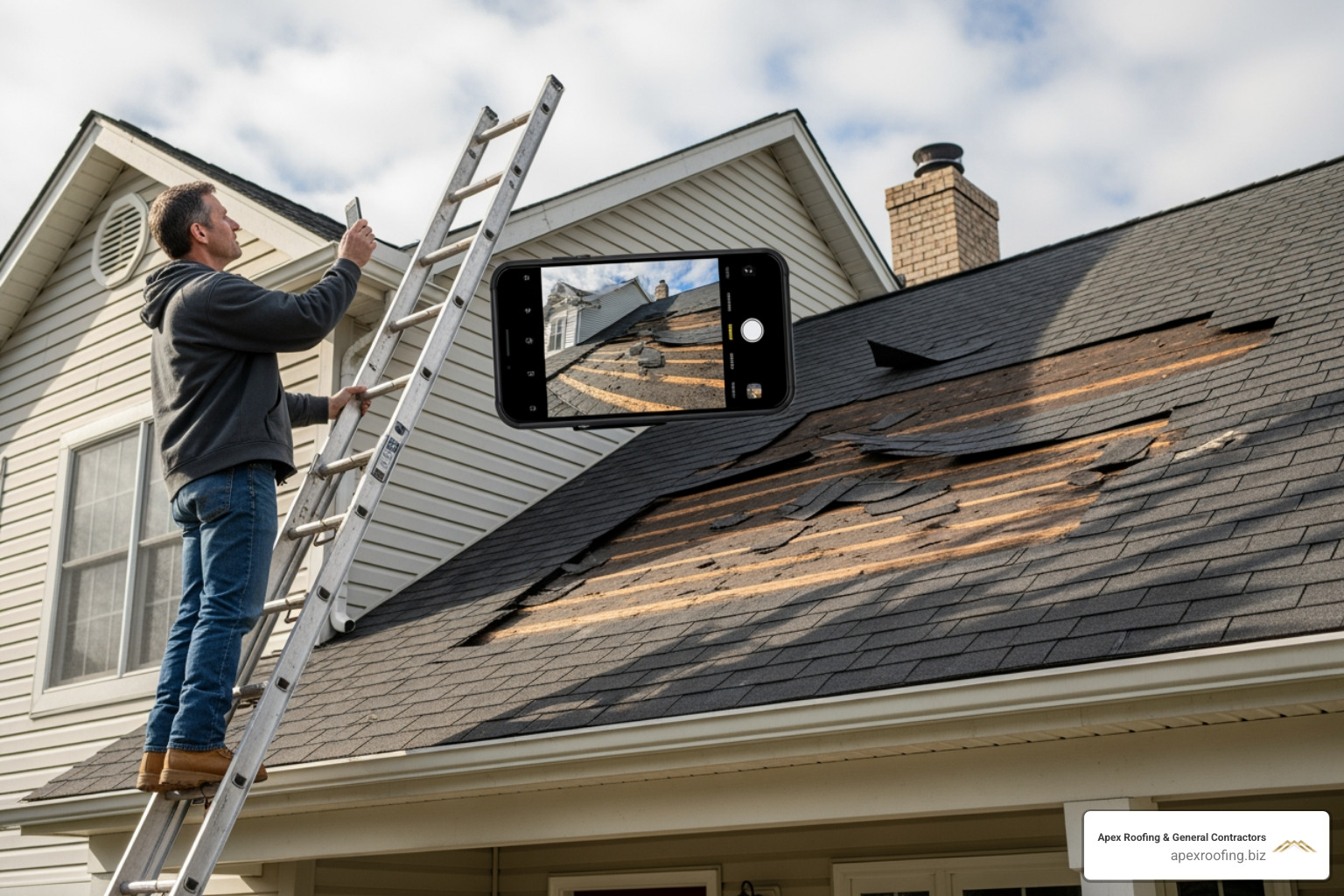
Filing roof insurance claims successfully requires a methodical approach. From the moment you spot damage, every action you take can impact your claim’s outcome. Following these essential steps will help ensure you receive a fair settlement.
Step 1: Immediate Safety and Damage Mitigation
Your family’s safety is the top priority. If you suspect structural damage, evacuate and call emergency services. Once safe, you must take reasonable steps to prevent further harm to your property, known as your “duty to mitigate.”
This often involves tarping damaged sections of the roof to prevent water intrusion. If you have an active leak, our guide on an emergency roof leak fix offers immediate solutions. Keep all receipts for temporary repairs, as these costs are typically reimbursable under your claim. Failing to mitigate damage can lead to the denial of coverage for any secondary issues that arise.
Step 2: Document Everything Thoroughly
Thorough documentation is the foundation of a strong claim. Your insurer relies on the evidence you provide to assess the damage.
- Take Photos and Videos: Capture clear, high-resolution photos of all damage from multiple angles. Videos of active leaks are especially powerful evidence.
- Document Interior Damage: Photograph water stains on ceilings, damaged drywall, or wet insulation.
- Record the Date of Loss: Note the exact date the storm occurred and save local weather reports as proof.
- Keep a Written Log: Detail the location and nature of all damage observed.
- Find “Before” Photos: Pictures of your roof in good condition prior to the storm are invaluable for proving the damage is new.
Step 3: Get a Professional Inspection and Estimate
Before filing your claim, get an inspection from a qualified roofing contractor. An expert can identify subtle damage that an untrained eye—or even an adjuster—might miss, such as granule loss or hairline cracks.
A residential roof inspection in San Antonio, TX provides a detailed, unbiased report and an itemized estimate for repairs. With the average roof replacement costing around $9,150, this professional assessment sets a realistic baseline for your claim and strengthens your negotiating position. A contractor’s estimate, based on local material and labor costs, is a crucial tool for ensuring your settlement is adequate.
Step 4: Contact Your Insurance Company
With your documentation and professional estimate in hand, it’s time to officially file your roof insurance claim. Most policies require you to report damage promptly, so don’t delay.
When you call your insurer, you will be assigned a claim number—keep this for all future communications. Provide all the evidence you’ve gathered, including your contractor’s report. The more information you give upfront, the smoother the process will be. The insurer will then schedule an adjuster to inspect your property. For a detailed overview, review this step-by-step guide on filing a roof damage claim.
Working with Adjusters and Contractors
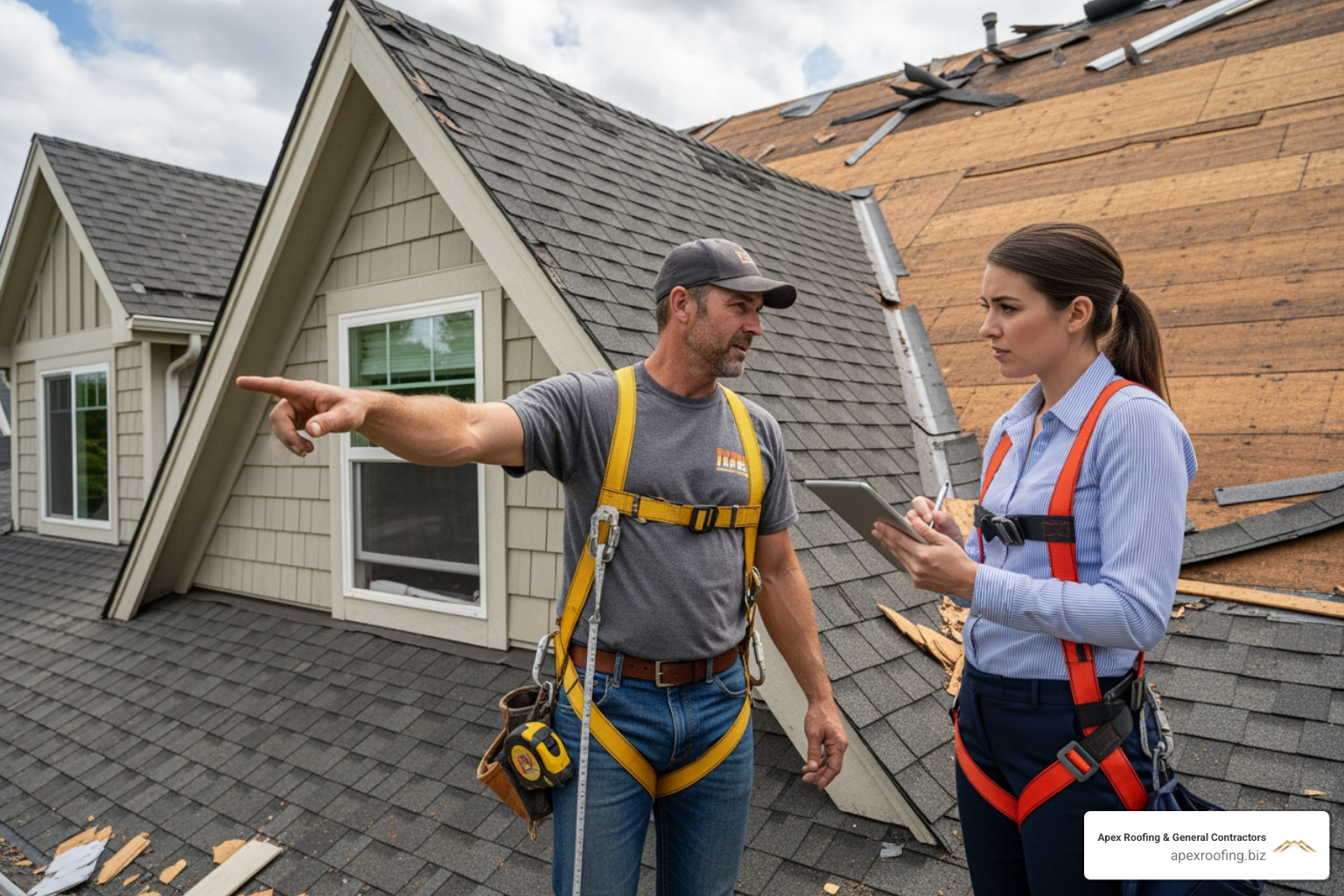
After filing your roof insurance claim, you’ll work closely with an insurance adjuster and your chosen roofing contractor. Understanding their roles is key to securing a fair settlement that covers all necessary repairs.
The Role of the Insurance Adjuster
The insurance adjuster works for the insurance company. Their job is to investigate your claim, verify the cause of loss, assess the scope of damage, and determine the settlement amount. Adjusters often use software like Xactimate to create estimates based on standard local pricing.
To ensure a fair assessment, be present during the adjuster’s inspection. Have your documentation ready, including your contractor’s report. Most importantly, have your roofing contractor meet the adjuster on-site. A contractor can point out subtle damage and speak the same technical language, ensuring nothing is overlooked.
Benefits of Hiring a Contractor for Your Roof Insurance Claims
Hiring a roofer experienced with insurance claims, like Apex Roofing & General Contractors, provides you with a powerful advocate. The benefits include:
- Expert Damage Identification: We spot all storm-related damage, ensuring a complete assessment.
- Accurate Scope Negotiation: We use our expertise and knowledge of local pricing to negotiate a fair scope of work with the adjuster.
- Code Compliance: We ensure your claim includes necessary upgrades to meet current San Antonio building codes, which are often covered by insurance.
- Settlement Maximization: By documenting all damage and costs accurately, we help you receive the full settlement you’re entitled to under your policy.
Red Flags: How to Spot and Avoid Roofing Scams
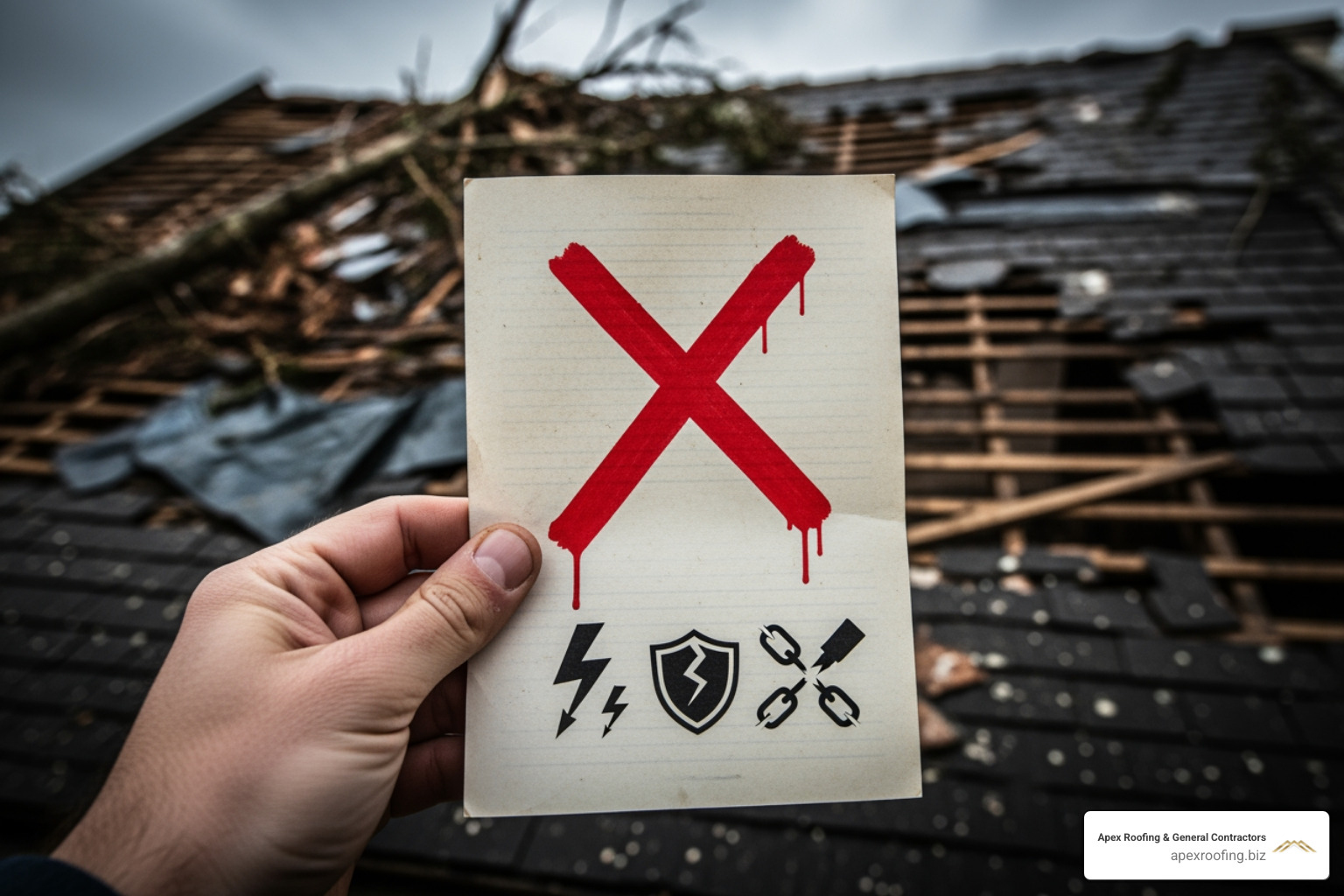
After a storm, be wary of unethical contractors known as “storm chasers.” Protect yourself by watching for these red flags:
- High-Pressure Sales Tactics: Legitimate contractors give you time to make informed decisions.
- Offers to Waive Your Deductible: This is insurance fraud and illegal. Your deductible is your responsibility.
- Large Upfront Payments: Never pay in full before the work is complete. A reasonable deposit is standard, but full payment is a major red flag.
- Lack of Credentials: Always verify the contractor is licensed and insured. Ask for proof of general liability and workers’ compensation insurance.
- Vague or Missing Contracts: Demand a detailed written contract outlining the scope of work, materials, timeline, and costs.
- Out-of-State Plates or No Local Office: Storm chasers often lack a local presence and will be gone when you need them for warranty issues. Learn more about these signs that a roofer is a storm chaser.
Handling Claim Outcomes and Preparing for the Future
The initial settlement offer for your roof insurance claim is often a starting point for negotiation. Knowing how to respond to the outcome—whether it’s a denial, an underpayment, or a fair offer—is critical for protecting your finances.
What to Do if Your Roof Insurance Claims are Denied or Underpaid
A denied or underpaid claim is frustrating, but it’s not the final word. You have recourse. Follow these steps:
- Review the Denial Letter: Your insurer must provide a specific reason for their decision. This tells you what you need to contest.
- Request a Second Inspection: Ask for another adjuster to visit, and make sure your contractor is present to point out all damage and advocate on your behalf.
- File a Formal Appeal: Submit a formal appeal to the insurance company with all your documentation, including your contractor’s report, photos, and weather data.
- Consider a Public Adjuster: If the appeal fails, a public adjuster works for you (not the insurer) to negotiate a better settlement. They typically charge a percentage of the final claim amount.
- Explore Legal Options: As a last resort, an attorney specializing in insurance law can help, especially if you suspect your insurer is acting in bad faith. Understanding Texas insurance guidelines can also inform your rights.
The Implications of Filing Multiple Claims
While insurance is there to protect you, filing multiple claims in a short period (typically 3-5 years) can have negative consequences. Insurers may see you as a higher risk, which can lead to:
- Increased Premiums: Your rates may go up at renewal time.
- Non-Renewal: Your insurer could decide not to renew your policy, making it harder and more expensive to find new coverage.
Because of this, it’s wise to only file claims for significant damage where the repair cost is substantially more than your deductible. For minor repairs, paying out of pocket can be a better long-term financial strategy.
Proactive Steps to Prepare for Future Claims
The best way to ensure a smooth claims process is to prepare before a storm hits. Take these proactive steps:
- Get Annual Roof Inspections: A professional can identify and fix minor issues before they become major problems and document your roof’s condition.
- Maintain a Roof File: Keep all records, including installation contracts, inspection reports, repair invoices, and warranties, in one place.
- Document Maintenance: Keep receipts and photos of any maintenance, like gutter cleaning or minor repairs, to counter claims of neglect.
- Take “Before” Photos: Periodically photograph your roof when it’s in good condition to serve as a baseline.
- Review Your Policy Annually: Understand your coverage, deductibles, and whether you have an ACV or RCV policy. This helps avoid surprises when you need to file a claim.
Frequently Asked Questions about Roof Insurance Claims
Homeowners often have similar concerns when navigating roof insurance claims. Here are straightforward answers to the most common questions we hear at Apex Roofing & General Contractors.
How long do I have to file a roof claim after a storm?
Most insurance policies require you to file a claim within one year from the date of the storm, but you should report damage as soon as possible. Waiting too long can give the insurer a reason to question the claim’s validity or deny it for late filing. Always check your specific policy for the exact deadline, but prompt action is your best strategy.
Can my insurance company force me to use their preferred contractor?
No. In Texas and most other states, you have the legal right to choose any licensed and insured roofing contractor you trust. While an insurer may offer a list of “network” contractors, you are not obligated to use them. Choosing an independent contractor who works for you, not the insurance company, ensures your best interests are the top priority.
Will my insurance rates go up if I file a single roof claim?
Filing a single claim for storm damage, especially after a widespread weather event, will not typically cause a significant rate increase. Insurers anticipate these “act of God” claims. However, filing multiple claims within a few years (e.g., three to five) can flag your property as high-risk, potentially leading to higher premiums or non-renewal. If repair costs are only slightly more than your deductible, consider paying out of pocket to protect your claims history. For specific advice, call us at (726) 727-7663.
Get Your Roof—and Your Peace of Mind—Back
Navigating a roof insurance claim can be complex, but with the right knowledge and professional partner, you can protect your home and your finances. Understanding your policy, documenting damage thoroughly, and working with an experienced contractor are the keys to a successful outcome.
Don’t let a damaged roof put your home at risk. In the San Antonio area, from Helotes to Alamo Heights, the certified team at Apex Roofing & General Contractors is ready to guide you. We handle the inspections, meet with adjusters, and manage the repairs, ensuring you receive a fair settlement and a high-quality roof.
Our goal is to restore your roof and your peace of mind as quickly and smoothly as possible. For a free inspection and free estimate, call us today at (726) 727-7663. Let our team guide you through every stage of your claim.


